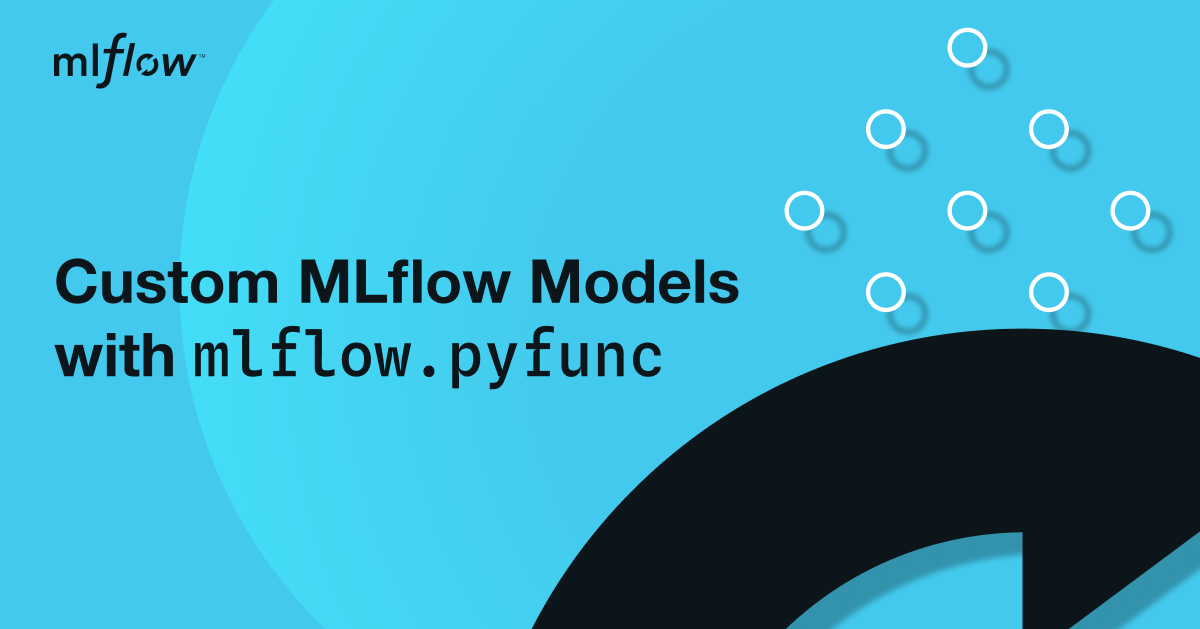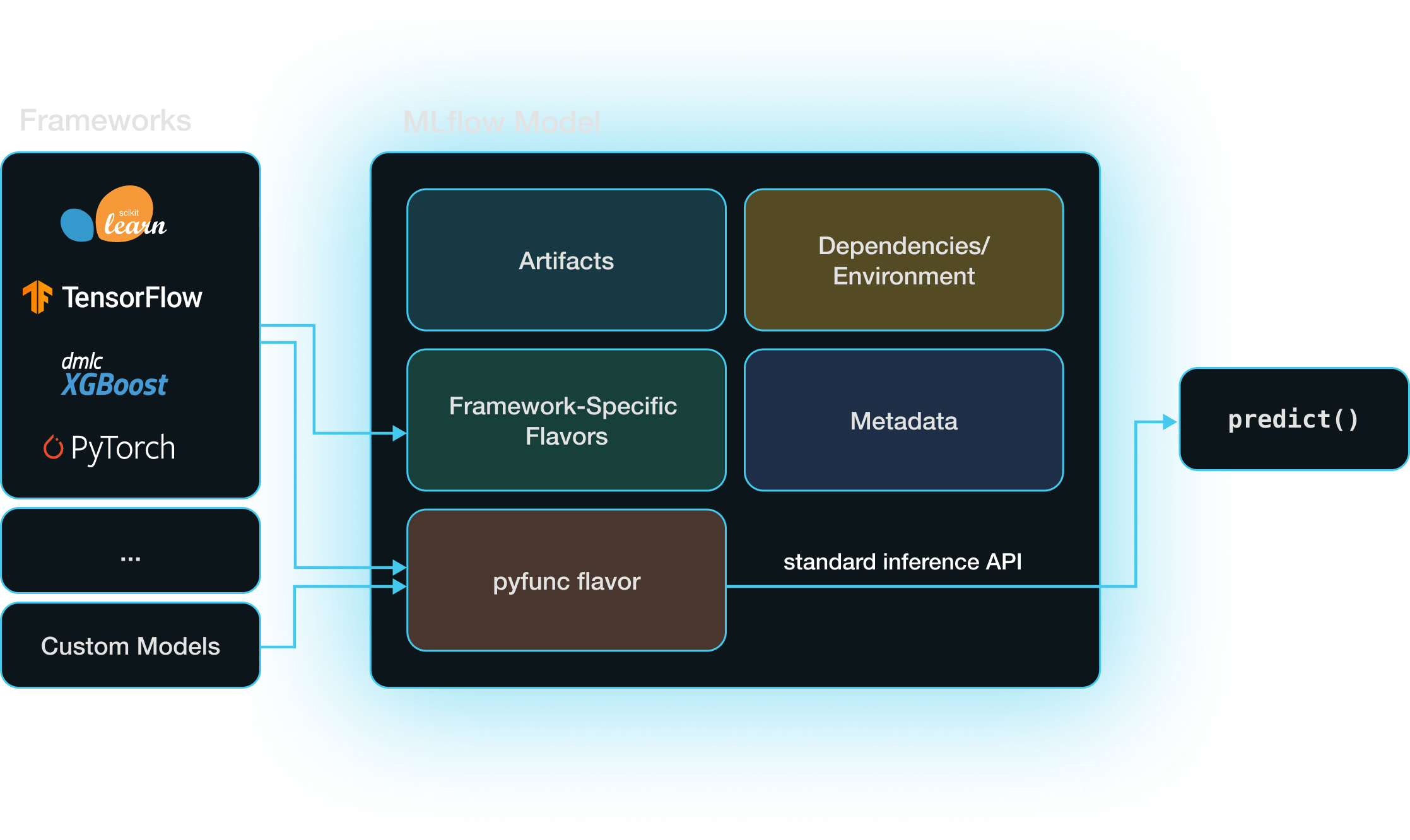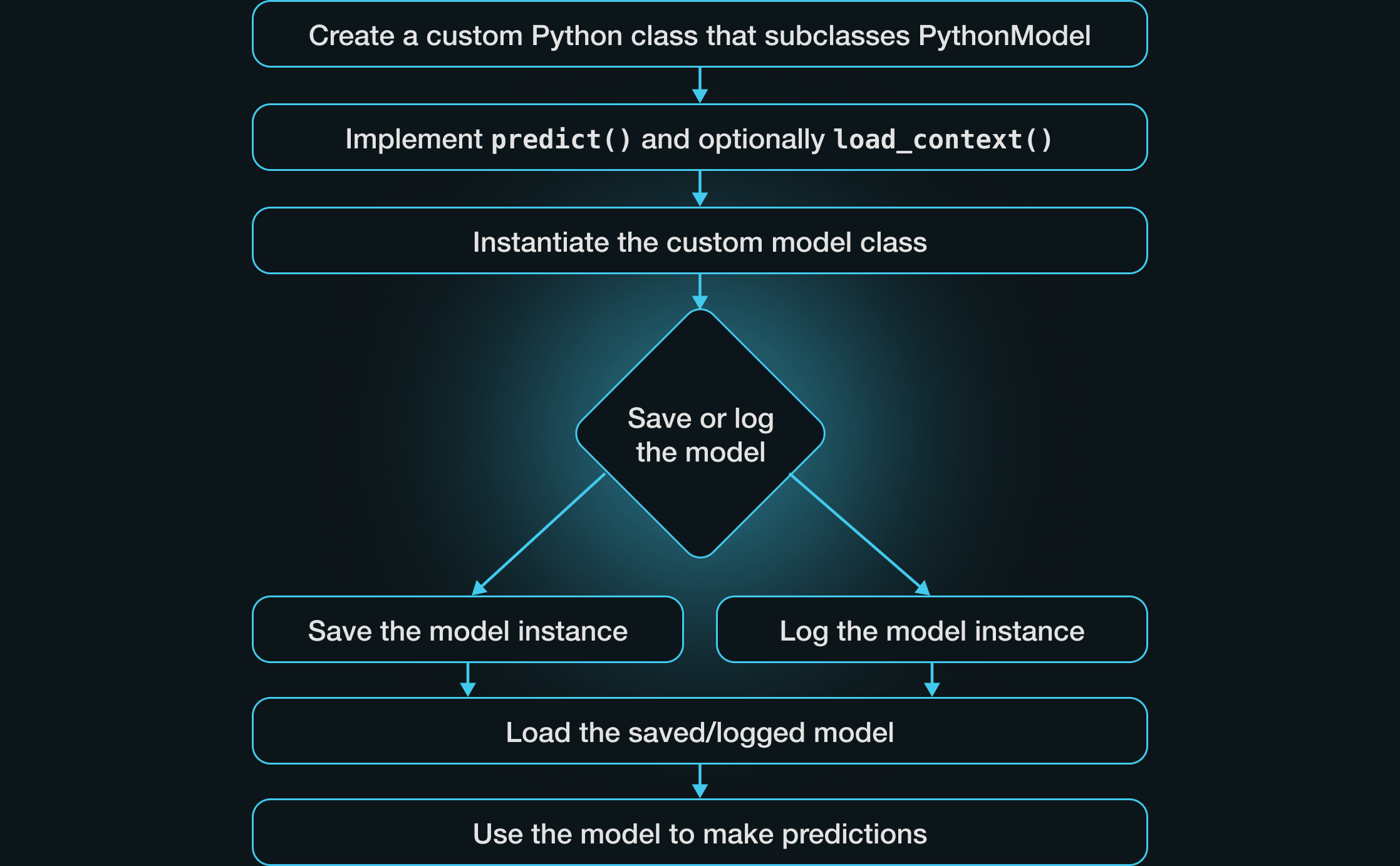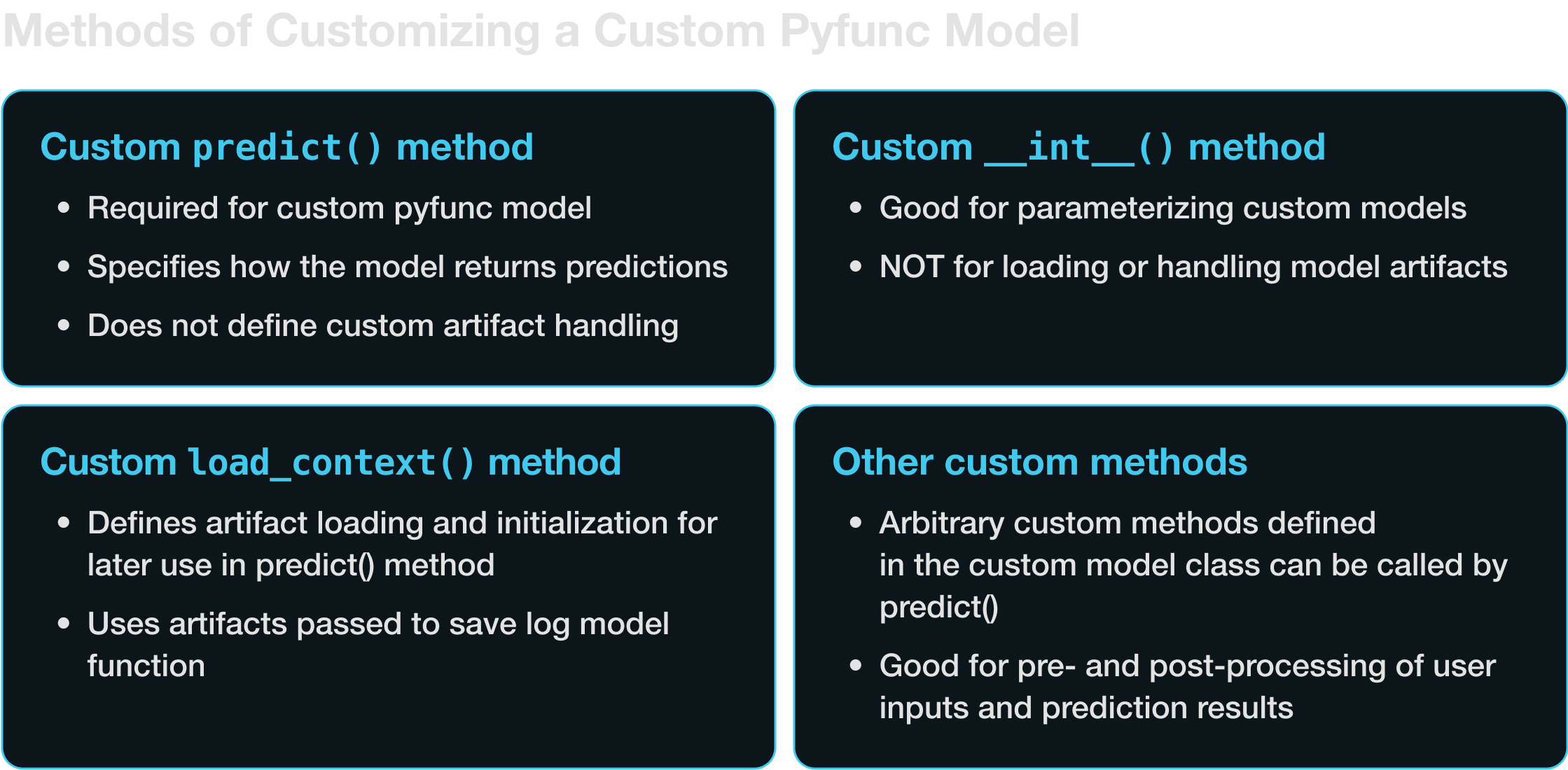Custom MLflow Models with mlflow.pyfunc
If you're looking to learn about all of the flexibility and customization that is possible within MLflow's custom models, this blog will help you on your journey in understanding more about how to leverage this powerful and highly customizable model storage format.

MLflow offers built-in methods for logging and working with models from many popular machine learning and generative AI frameworks and model providers, such as scikit-learn, PyTorch, HuggingFace transformers, and LangChain. For example, mlflow.sklearn.log_model will log a scikit-learn model as an MLflow artifact without requiring you to define custom methods for prediction or for handling artifacts.
In some cases, however, you might be working in a framework for which MLflow does not have built-in methods, or you might want something different than the model’s default prediction outputs. In those cases, MLflow allows you to create custom models to work with essentially any framework and to integrate custom logic to existing supported frameworks.
In its simplest form, all that’s required is to define a custom predict method and log the model. The following example defines a simple pyfunc model that just returns the square of its input:
import mlflow
# Define a custom model
class MyModel(mlflow.pyfunc.PythonModel):
def predict(self, context, model_input):
# Directly return the square of the input
return model_input**2
# Save the model
with mlflow.start_run():
model_info = mlflow.pyfunc.log_model(
artifact_path="model",
python_model=MyModel()
)
# Load the model
loaded_model = mlflow.pyfunc.load_model(
model_uri=model_info.model_uri
)
# Predict
loaded_model.predict(2)
Let’s dig into how this works, starting with some basic concepts.
Models and Model Flavors

An MLflow model is a directory that includes everything needed to reproduce a machine learning model
across different environments. Aside from the stored model itself, the most important component
stored is an MLmodel YAML file that specifies the model’s supported model flavors.
A model flavor
is a set of rules specifying how MLflow can interact with the model (i.e., save it, load it, and
get predictions from it).
When you create a custom model in MLflow, it has the python_function or pyfunc model flavor,
which is a kind of “universal translator” across formats in MLflow. When you save a model in MLflow
using a built-in model flavor, e.g. with mlflow.sklearn.log_model,
that model also has the pyfunc model flavor in addition to its framework-specific flavor.
Having both framework-specific and pyfunc model flavors allows you to use the model via the
framework’s native API (e.g., scikit-learn) or via the pyfunc flavor’s framework-agnostic inference API.
Models with the pyfunc flavor are loaded as instances of the mlflow.pyfunc.PyfuncModel class, which exposes a standardized predict method. This enables straightforward inference through a single function call, regardless of the underlying model's implementation details.
Defining Custom MLflow Pyfunc Models
Saving a model from any supported machine learning framework as an MLflow model results in the creation of a pyfunc model flavor that provides a framework-agnostic interface for managing and using the model. But what if you’re using a framework without an MLflow integration, or you’re trying to elicit some custom behavior from a model? Custom pyfunc models allow you to work with essentially any framework and to integrate custom logic.
To implement a custom pyfunc model, define a new Python class inheriting from the PythonModel class and implement the necessary methods. Minimally, this will involve implementing a custom predict method. Next, create an instance of your model and log or save the model. Once you’ve loaded the saved or logged model, you can use it for predictions.

Let’s work through a few examples, each adding a little more complexity and highlighting different aspects of defining a custom pyfunc model. We’ll cover four main techniques for implementing custom behaviors in pyfunc models:
- Implementing a custom
predictmethod - Implementing a custom
__init__method - Implementing a custom
load_contextmethod - Implementing user-defined custom methods

Defining a custom predict method
At a minimum, a pyfunc model should specify a custom predict method that defines what happens when
we call model.predict. Here’s an example of a custom model that applies a simple linear
transformation to the model inputs, multiplying each input by two and adding three:
import pandas as pd
import mlflow
from mlflow.pyfunc import PythonModel
# Custom PythonModel class
class SimpleLinearModel(PythonModel):
def predict(self, context, model_input):
"""
Applies a simple linear transformation
to the input data. For example, y = 2x + 3.
"""
# Assuming model_input is a pandas DataFrame with one column
return pd.DataFrame(2 * model_input + 3)
with mlflow.start_run():
model_info = mlflow.pyfunc.log_model(
artifact_path="linear_model",
python_model=SimpleLinearModel(),
input_example=pd.DataFrame([10, 20, 30]),
)
Note that you can (and should) also include a signature and an input example when saving/logging a model. If you pass an input example, the signature will be inferred automatically. The model signature provides a way for MLflow to enforce correct usage of your model.
Once we’ve defined the model path and saved an instance of the model, we can load the saved model and use it to generate predictions:
# Now the model can be loaded and used for predictions
loaded_model = mlflow.pyfunc.load_model(model_uri=model_info.model_uri)
model_input = pd.DataFrame([1, 2, 3]) # Example input data
print(loaded_model.predict(model_input)) # Outputs transformed data
Which will return:
: 0
: 0 5
: 1 7
: 2 9
Note that if a custom predict method is all you need—that is, if your model does not have any
artifacts that require special handling—you can save or log the predict method directly without
needing to wrap it in a Python class:
import mlflow
import pandas as pd
def predict(model_input):
"""
Applies a simple linear transformation
to the input data. For example, y = 2x + 3.
"""
# Assuming model_input is a pandas DataFrame with one column
return pd.DataFrame(2 * model_input + 3)
# Pass predict method as python_model argument to save/log model
with mlflow.start_run():
model_info = mlflow.pyfunc.log_model(
artifact_path="simple_function",
python_model=predict,
input_example=pd.DataFrame([10, 20, 30]),
)
Note that with this approach, we must include an input example along with the custom predict method. We also have to modify the predict method such that it takes only one input (i.e., no self or context). Running this example and then loading with the same code as the preceding code block will retain the same output as the example using a class definiton.
Parameterizing the custom model
Now suppose we want to parameterize the custom linear function model so that it can be used with
different slopes and intercepts. We can define the __init__ method to set up custom parameters,
as in the following example. Note that the custom model class’s __init__ method should not be used
to load external resources like data files or pretrained models; these are handled in the
load_context method, which we’ll discuss shortly.
import pandas as pd
import mlflow
from mlflow.pyfunc import PythonModel
# Custom PythonModel class
class ParameterizedLinearModel(PythonModel):
def __init__(self, slope, intercept):
"""
Initialize the parameters of the model. Note that we are not loading
any external resources here, just setting up the parameters.
"""
self.slope = slope
self.intercept = intercept
def predict(self, context, model_input):
"""
Applies a simple linear transformation
to the input data. For example, y = 2x + 3.
"""
# Assuming model_input is a pandas DataFrame with one column
return pd.DataFrame(self.slope * model_input + self.intercept)
linear_model = ParameterizedLinearModel(10, 20)
# Saving the model with mlflow
with mlflow.start_run():
model_info = mlflow.pyfunc.log_model(
artifact_path="parameter_model",
python_model=linear_model,
input_example=pd.DataFrame([10, 20, 30]),
)
Again, we can load this model and make some predictions:
loaded_model = mlflow.pyfunc.load_model(model_uri=model_info.model_uri)
model_input = pd.DataFrame([1, 2, 3]) # Example input data
print(loaded_model.predict(model_input)) # Outputs transformed data
: 0
: 0 30
: 1 40
: 2 50
There are many cases where we might want to parameterize a model in this manner. We can define
variables in the __init__ method to:
- Set model hyperparameters.
- A/B test models with different parameter sets.
- Set user-specific customizations.
- Toggle features.
- Set, e.g., access credentials and endpoints for models that access external APIs.
In some cases, we may want to be able to pass parameters at inference time rather than when we
initialize the model. This can be accomplished with
model inference params. To use
inference params, we must pass a valid model signature including params. Here’s how to adapt the
preceding example to use inference params:
import pandas as pd
import mlflow
from mlflow.models import infer_signature
from mlflow.pyfunc import PythonModel
# Custom PythonModel class
class LinearFunctionInferenceParams(PythonModel):
def predict(self, context, model_input, params):
"""
Applies a simple linear transformation
to the input data. For example, y = 2x + 3.
"""
slope = params["slope"]
# Assuming model_input is a pandas DataFrame with one column
return pd.DataFrame(slope * model_input + params["intercept"])
# Set default params
params = {"slope": 2, "intercept": 3}
# Define model signature
signature = infer_signature(model_input=pd.DataFrame([10, 20, 30]), params=params)
# Save the model with mlflow
with mlflow.start_run():
model_info = mlflow.pyfunc.log_model(
artifact_path="model_with_params",
python_model=LinearFunctionInferenceParams(),
signature=signature,
)
After loading the model as before, you can now pass a params argument to the predict method,
enabling you to use the same loaded model for different combinations of parameters:
loaded_model = mlflow.pyfunc.load_model(model_uri=model_info.model_uri)
parameterized_predictions = loaded_model.predict(
pd.DataFrame([10, 20, 30]), params={"slope": 2, "intercept": 10}
)
print(parameterized_predictions)
: 0
: 0 30
: 1 50
: 2 70
Loading external resources with load_context
Custom models often require external files such as model weights in order to perform inference.
These files, or artifacts, must be handled carefully to avoid unnecessarily loading files into
memory or errors during model serialization. When building custom pyfunc models in MLflow, you can
use the load_context method to handle model artifacts correctly.
The load_context method receives a context object containing artifacts the model can use during
inference. You can specify these artifacts using the artifacts argument when saving or logging
models, making them accessible to the load_context method via the context.artifacts dictionary.
In practice, the load_context method often initializes the model called by the predict method by
handling the loading of model artifacts.
This raises an important question: why do we load artifacts and define the model in the load_context
method and not in __init__ or directly in predict? Correct usage of load_context is essential
for the maintainability, efficiency, scalability, and portability of MLflow pyfunc models. This is because:
- The
load_contextmethod is executed once when the model is loaded viamlflow.pyfunc.load_model. This setup ensures that resource-intensive processes defined within this method, such as loading large model files, are not repeated unnecessarily. If artifact loading is done in the predict method, it will occur every single time a prediction is made. This is highly inefficient for resource-intensive models. - Saving or logging an MLflow
pyfuncmodel involves serializing the Python model class (the subclass of mlflow.pyfunc.PythonModel you created) and its attributes. Complex ML models are not always compatible with the methods used to serialize the Python object, which can lead to errors if they are created as attributes of the Python object.
As an example, suppose we want to load a large language model (LLM) in the gguf model format
(a file format designed for storing models for inference) and run it with the
ctransformers library. At the time of writing, there is
no built-in model flavor that lets us use gguf models for inference, so we’ll create a custom
pyfunc model that loads the required libraries and model files in the load_context method.
Specifically, we’re going to load a quantized version of the AWQ version of the Mistral 7B model.
First, we’ll download the model snapshot using the huggingface hub cli:
huggingface-cli download TheBloke/Mistral-7B-v0.1-GGUF \
mistral-7b-v0.1.Q4_K_M.gguf \
--local-dir /path/to/mistralfiles/ \
--local-dir-use-symlinks False
And then we’ll define our custom pyfunc model. Note the addition of the load_context method:
import ctransformers
from mlflow.pyfunc import PythonModel
class CTransformersModel(PythonModel):
def __init__(self, gpu_layers):
"""
Initialize with GPU layer configuration.
"""
self.gpu_layers = gpu_layers
self.model = None
def load_context(self, context):
"""
Load the model from the specified artifacts directory.
"""
model_file_path = context.artifacts["model_file"]
# Load the model
self.model = ctransformers.AutoModelForCausalLM.from_pretrained(
model_path_or_repo_id=model_file_path,
gpu_layers=self.gpu_layers,
)
def predict(self, context, model_input):
"""
Perform prediction using the loaded model.
"""
if self.model is None:
raise ValueError(
"The model has not been loaded. "
"Ensure that 'load_context' is properly executed."
)
return self.model(model_input)
There’s a lot going on here, so let’s break it down. Here are the key points:
- As before, we use the
__init__method to parameterize the model (in this case, to set thegpu_layersargument for the model). - The purpose of the
load_contextmethod is to load the artifacts required for use in thepredictmethod. In this case, we need to load the model and its weights. - You’ll notice that we reference
context.artifacts["model_file"]. This comes from the artifacts argument tomlflow.pyfunc.save_modelormlflow.pyfunc.load_model, as shown in the following code snippet. This is an important part of working withpyfuncmodels. Thepredictandload_contextmethods can access the artifacts defined in the artifacts argument to thesave_modelorlog_modelmethod via thecontext.artifactsobject.load_contextis executed when the model is loaded viaload_model; as described earlier, this provides a way to ensure that the potentially time-consuming initialization of a model does not occur each time the model is used for prediction.
Now we can initialize and save an instance of the model. Note the artifacts argument to the
save_model function:
# Create an instance of the model
mistral_model = CTransformersModel(gpu_layers=50)
# Log the model using mlflow with the model file as an artifact
with mlflow.start_run():
model_info = mlflow.pyfunc.log_model(
artifact_path="mistral_model",
python_model=mistral_model,
artifacts={"model_file": model_file_path},
pip_requirements=[
"ctransformers==0.2.27",
],
)
# Load the saved model
loaded_model = mlflow.pyfunc.load_model(model_info.model_uri)
# Make a prediction with the model
loaded_model.predict("Question: What is the MLflow Pyfunc model flavor?")
To recap: correct use of the load_context method helps to ensure efficient handling of model
artifacts and prevents errors in serialization that could result from attempting to define artifacts
as model attributes.
Defining custom methods
You can define your own methods in the custom pyfunc model to handle tasks like preprocessing
inputs or post-processing outputs. These custom methods can then be called by the predict method.
Keep in mind that these custom methods, just like __init__ and predict, should not be used for
loading artifacts. Loading artifacts is the exclusive role of the load_context method.
For example, we can modify the CTransformersModel to incorporate some prompt formatting as follows:
import ctransformers
from mlflow.pyfunc import PythonModel
class CTransformersModel(PythonModel):
def __init__(self, gpu_layers):
"""
Initialize with GPU layer configuration.
"""
self.gpu_layers = gpu_layers
self.model = None
def load_context(self, context):
"""
Load the model from the specified artifacts directory.
"""
model_file_path = context.artifacts["model_file"]
# Load the model
self.model = ctransformers.AutoModelForCausalLM.from_pretrained(
model_path_or_repo_id=model_file_path,
gpu_layers=self.gpu_layers,
)
@staticmethod
def _format_prompt(prompt):
"""
Formats the user's prompt
"""
formatted_prompt = (
"Question: What is an MLflow Model?\n\n"
"Answer: An MLflow Model is a directory that includes "
"everything that is needed to reproduce a machine "
"learning model across different environments. "
"It is essentially a container holding the trained model "
"files, dependencies, environment details, input examples, "
"and additional metadata. The directory also includes an "
"MLmodel YAML file, which describes the different "
f"flavors of the model.\n\nQuestion: {prompt}\nAnswer: "
)
return formatted_prompt
def predict(self, context, model_input):
"""
Perform prediction using the loaded model.
"""
if self.model is None:
raise ValueError(
"Model was not loaded. Ensure that 'load_context' "
"is properly executed."
)
return self.model(self._format_prompt(model_input))
Now the predict method can access the private _format_prompt static method to apply custom formatting to the prompts.
Dependencies and Source Code
The custom CTransformersModel defined above uses the ctransformers library. There are a few
different approaches for making sure this library (and any other source code, including from your
local device) is correctly loaded with your model. Correctly specifying dependencies is essential
for ensuring that custom models work as expected across environments.
There are three main approaches to be aware of for specifying dependencies:
- Define pip requirements explicitly with the
pip_requirementsargument tosave_modelorlog_model. - Add extra pip requirements to an automatically generated set of requirements with the
extra_pip_requirementsargument tosave_modelorlog_model. - Define a Conda environment with the
conda_envargument tosave_modelorlog_model.
Earlier, we used the first approach to specify that the ctransformers library was needed:
# Log the model using mlflow with the model file as an artifact
with mlflow.start_run():
model_info = mlflow.pyfunc.save_model(
artifact_path="mistralmodel",
python_model=mistral_model,
artifacts={"model_file": "path/to/mistral/model/on/local/filesystem"},
pip_requirements=[
"ctransformers==0.2.27",
],
)
If you do not specify dependencies explicitly, MLflow will attempt to infer the correct set of
requirements and environment details. To enable greater accuracy, it is strongly recommended to
include an input_example when saving or logging your model due to the internal execution of a
sample inference step that will capture any loaded library references associated with the inference
execution, enabling a higher probability that the correct dependencies will be recorded.
You can also work with custom code on your own filesystem with the code_path argument.
code_path takes a list of paths to Python file dependencies and prepends them to the system
path before the model is loaded, so the custom pyfunc model can import from these modules.
See the documentation for the log_model and
save_model
functions for more details on the accepted formats for pip, Conda, and local code requirements.
Summary: Custom Pyfunc Models in MLflow
MLflow has built-in methods for working with models from many popular machine learning frameworks,
such as scikit-learn,
PyTorch, and
Transformers. You can define your own custom
mlflow.pyfunc model when you want to work with models that do not yet have built-in model
flavors, or when you want to implement a custom predict method for models with built-in model flavors.
There are several ways to customize pyfunc models to get the desired behavior. Minimally, you can
implement a custom predict method. If your model requires saving or loading artifacts, you should also
implement a load_context method. For further customization, you can use the __init__ method for
setting custom attributes and define your own custom methods for pre- and post-processing.
Combining these approaches gives you the ability to flexibly define custom logic for your machine
learning models.
Further Learning
Interested in learning more about custom pyfunc implementations? You can visit:
